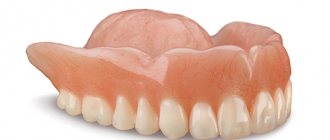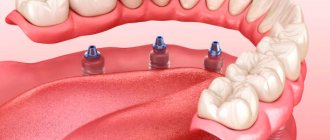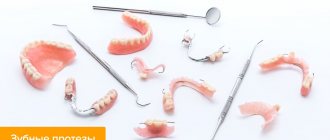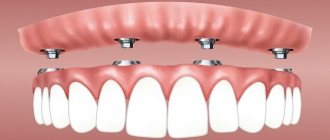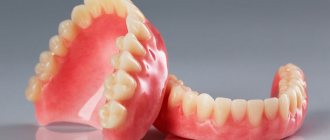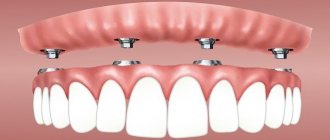From this article you will learn:
- what types of dentures are there?
- pros and cons of different removable dentures,
- New generation removable dentures without palate – price 2021.
Removable dentures mean those dentures that the patient can take off and put on himself. As a rule, they are made only when there are a large number of missing teeth - in cases where there is no possibility of permanent prosthetics with bridges or through dental implants.
In addition to traditional types of removable dentures, in recent years conditionally removable dentures on implants, as well as new generation removable dentures without a palate, have been gaining popularity. Below you can learn about the advantages and disadvantages of both traditional and modern types of dentures.
Types of removable dentures –
Which dentures are best to install will depend primarily on the number of remaining teeth. One type of denture is more suitable for complete absence of teeth, the other for partial absence. Below we will analyze all types of removable dentures that can be made in case of complete or partial absence of teeth...
Removable dentures in case of complete absence of teeth –
The absence of supporting teeth with their complete absence leads to the fact that the chewing load can be transferred from the prosthesis only to the alveolar processes of the jaws (gum), which always leads to fairly rapid gum atrophy, i.e.
to reduce its height. The latter circumstance leads to the fact that removable dentures should be changed on average every 2.5-3 years, because the prosthesis no longer corresponds to the tissues of the prosthetic bed. Another problem with prosthetics in the absence of teeth is fixation of the prosthesis (especially when it comes to the lower jaw). There is even the term “suction cup dentures” (Fig. 1). We are talking here about plastic prostheses, which are relatively well fixed when prosthetics are applied to the upper jaw, but in the lower jaw it is basically impossible to achieve good fixation of the prosthesis unless mini-implants are installed under the prosthesis.
In case of complete absence of teeth, they are used –
- dentures made of acrylic plastic (Fig. 1-2),
- nylon prostheses,
- Acry-free prostheses,
- conditionally removable dentures.
Dentures for partial absence of teeth –
Partial removable dentures mean that the patient has at least one or more teeth left in the jaw, which will be preserved and used as supporting teeth. Abutment teeth are necessary for good fixation of the prosthesis in the oral cavity, as well as for distributing the chewing load from the prosthesis not only to the gums, but also to the abutment teeth.
It is the latter circumstance that determines the chewing efficiency of a removable denture, as well as comfort (painlessness when chewing). Some types of partial dentures restore chewing efficiency better than others, but they may have slightly poorer esthetics.
In case of partial absence of teeth, use –
- dentures made of acrylic plastic (Fig. 2),
- nylon prostheses,
- clasp type prostheses.
Below we will analyze in detail all these removable dentures - which are better, reviews about them, which of them can be made on the upper jaw without a palate, and also indicate their cost for 2021)…
Microprosthetics
This is the restoration of tooth structure using inlays (internal or cavity dentures) and onlays (full or partial veneers). Microprosthetics is a promising direction in the development of aesthetic and orthopedic dentistry. Microprosthetics refers to the concept of “dental restoration,” which implies the restoration of a partially destroyed tooth.
Evolution is taking place in prosthetic dentistry, primarily due to the emergence of new materials and treatment methods. If in the past they used rubber and a ceramic tooth embedded in it to create a removable denture, today they use composite materials, biologically neutral metal alloys, and modern methods of tooth root implantation.
Modern technologies and modern materials allow the orthopedic surgeon to achieve the most natural smile for the patient. Today, the fashion for a healthy, most natural smile is supported by modern possibilities in dentistry, and this must be taken advantage of.
Plastic dentures –
Plastic dentures are made from acrylic plastic. These dentures can be used for both complete and partial absence of teeth. Sometimes this type of denture is also called the term “removable plate denture”. Below we will describe all the pros and cons of this prosthesis for complete and partial absence of teeth.
Acrylic prosthesis with complete absence of teeth: reviews
Fixation of complete removable dentures made of plastic (Fig. 3-6) is carried out due to the so-called “closing valve” (suction cup effect). If the prosthesis is made correctly, then after you put the prosthesis on and bite on it, excess air will come out from under the prosthesis. However, air should not get back if the contour of the prosthesis very precisely fits the tissues of the prosthetic bed and has a good fit to them.
Complete removable denture for the upper jaw: before and after photos
Complete removable denture for the lower jaw: before and after photos
Thus, a discharged space is formed under the prosthesis, which holds the prosthesis. That is why patients often call such dentures – suction cup dentures. Moreover, it is best to make complete removable acrylic dentures on an individual impression tray (remember this term), which will ensure a more precise fit of the prosthesis to the tissues of the prosthetic bed, and therefore improve its fixation.
Which prostheses are better - nylon or acrylic... when prosthetics in such a situation is done with a complete removable nylon prosthesis, there will be no “suction cup effect” due to the high elasticity of the body of the nylon prosthesis. This means that if there is a complete absence of teeth in the upper jaw, it is best to choose a plate denture made of acrylic plastic.
When replacing the lower jaw with complete absence of teeth, the fixation of the acrylic prosthesis almost always leaves much to be desired (as with nylon prostheses), and almost all patients complain of periodic loss of the prosthesis when chewing and speaking. Of course, you can also use a special cream to improve the fixation of the prosthesis, but still the most effective solution is a conditionally removable acrylic prosthesis supported by 2-3 implants (read about this type of prosthesis below).
With regard to comfort and efficiency when chewing, dentures made of plastic are superior in these qualities to dentures made of nylon, because the latter deform uncontrollably under chewing load (due to the high elasticity of nylon), causing pain when eating.
Acrylic dentures for partial absence of teeth: reviews
A partial acrylic denture will have rigid wire clasps that will extend from the plastic base of the denture and cover the supporting teeth (Fig. 7-9). It is due to them that the partial plate denture made of plastic is fixed in the oral cavity (Fig. 10-11).
Partial removable dentures for the upper and lower jaws –
Because The clasp is grasped precisely by the outer teeth (located at the edges of defects in the dentition), then if the supporting teeth are located precisely in the smile zone, the clasp will be clearly visible on the front surface of the teeth. This can only be avoided if you give preference to other types of dentures (nylon or clasp).
For a nylon denture, the clasps are made of flexible pink nylon, and therefore they are almost invisible against the background of the gums (24stoma.ru). However, the fixation of a prosthesis with elastic clasps will be, to put it mildly, “not important,” and besides, such an elastic prosthesis will also be painful to chew. And the optimal solution for partial absence of teeth will always be only prosthetics with clasp-type dentures (read about them below).
- Types of removable dentures for 1-2 teeth (Fig. 12) - when the patient is missing only 1-2 teeth in a row, if the patient is young and does not want to grind adjacent teeth into crowns or implant implants into the bone - a denture can be an alternative butterfly made of acrylic plastic.
This type of prosthesis is especially popular when it is necessary to restore one of the distant chewing teeth. A condition for good fixation of such a prosthesis will be the presence of teeth on both sides of the defect (i.e., it is impossible to prosthetize the last tooth, which has nothing behind it, with such a prosthesis). Such a prosthesis is practically invisible on the teeth.
Acrylic dentures: pros and cons
In addition to the pros and cons that we have listed above, the advantages of plastic prostheses also include: ease of manufacture, maintainability in case of breakdowns, relatively low cost - in comparison with all other types of prostheses (see cost below).
The disadvantages of plastic prostheses also include:
- dentures are quite massive and take up a lot of space in the oral cavity,
- when replacing the upper jaw (both with complete and partial absence of teeth) - the base of the prosthesis will completely cover the palate, which will cause a temporary disturbance in the articulation of speech, and will also worsen taste sensitivity due to the overlap of taste buds located on the palate,
- when making lower jaw prosthetics with complete absence of teeth, the fixation of the prosthesis will be quite poor (as with nylon prostheses), and there can only be one way out of this situation - a conditionally removable acrylic prosthesis supported by 2-3 implants.
The service life of dentures made of acrylic plastic is the recommended average service life of 3-3.5 years. However, it can be adjusted depending on the rate of jaw bone atrophy. With an increased rate of atrophy, the service life is reduced to 2.5 years; with a slow rate of bone tissue atrophy, it can increase to 5 years.
Plastic dentures: prices 2021
Prices for acrylic removable dentures are for 2021. The first figure corresponds to economy-class clinics, the second – to clinics in the middle price segment (we recorded the lowest prices in paid departments of state dental clinics).
- Complete removable acrylic denture – → in the regions – from 12,000 to 20,000 rubles. → in Moscow – from 14,000 to 20,000 rubles. (but if made from expensive materials and on an individual impression tray, then the price will be about 25,000 rubles).
- For a partial removable denture - prices in most clinics will be similar to a complete removable denture (or only slightly less, but no more than 10-15%). But a butterfly prosthesis for one tooth – the price will start from 6,500 rubles.
Rules of care and wearing features
- Some people wear removable nylon dentures constantly, removing them only from time to time, which in itself is wrong, since the structure must be removed and washed with a stream of water after each meal. If this is not possible, then you need to at least rinse your mouth.
- Cleaning of the prosthesis is carried out twice a day, and special means and devices are used for these purposes. Of course, the patient should regularly brush his “real” teeth and rinse his mouth after every meal.
- If there is no special cleaning liquid, then regular toilet soap can be an alternative, but not toothpaste, and the brush should be very soft. At least twice a year, a nylon flexible prosthesis should be professionally cleaned, for which you just need to come to the A-Medic clinic.
- If for some reason the structure is not used for a long time, then in order to prevent drying out, it should be placed in a glass of water.
- After installing the product, you should not eat rough food for a while. And in order to quickly get used to the “foreign body” in your mouth, doctors recommend talking and reading aloud more.
- If discomfort occurs while wearing the structure, then you need to tell your dentist about all your feelings.
- It is not recommended to drop a soft dental prosthesis, and in order for it to last longer, it must be handled very carefully.
Removable dentures made of nylon –
These are so-called soft removable dentures, made of elastic nylon (Fig. 13-15).
They are used for both complete and partial absence of teeth. Thanks to the properties of nylon, dentures made from this material can be made thinner and lighter than dentures made from plastic. In addition, nylon has a high degree of elasticity and flexibility, which makes these prostheses more comfortable to wear. In addition, removable dentures made of nylon have very good aesthetics and are practically invisible in the oral cavity. This is due to the fact that the gingival clasps of the nylon prosthesis (necessary for its fixation) are also made of pink nylon, which makes them invisible against the background of the pink shell of the gums. In turn, in plastic and clasp dentures the clasps are made of metal, and therefore they are clearly visible when they are in the smile line.
Dentures: photo
However, this is where the positive properties of such prostheses end. Reviews of nylon prostheses in the vast majority of cases are negative, which, paradoxically, is due precisely to the flexibility and elasticity of such prostheses. All the negative properties of nylon are fully manifested precisely when chewing pressure is transferred from a soft elastic prosthesis to the tissue of the prosthetic bed.
The high elasticity of the nylon prosthesis base leads to –
- to rapid atrophy of bone tissue under the prosthesis,
- rapid subsidence of the prosthesis and the need to replace it,
- painful chewing of food,
- the need for frequent corrections of the prosthesis,
- In addition, the prosthesis has a rough surface, which leads to the fairly rapid formation of a bacterial film on its surface.
Removable nylon dentures: price
For removable nylon dentures - the price is indicated for 2021 (the first figure is the cost in economy-class clinics, the second - in clinics of the middle price segment) ...
- complete removable denture – from 32,000 to 47,000 rubles.
- partial removable denture – from 26,000 to 40,000 rubles.
- butterfly denture made of nylon (for 1-2 teeth) – from RUB 17,000.
Selection rules
The doctor can advise you on the most suitable prosthesis after assessing the condition of the oral cavity, type of bite, number and location of teeth. Of course, the best option is implantation, which allows you to create a solid support and evenly distribute the load on the bone tissue. However, this procedure is very expensive, so you can resort to other modern denture technologies.
When choosing them, you should focus on the comfort of wearing the prosthesis and the absence of contraindications. When deciding on the design itself, you need to pay attention to the strength of the base and the environmental friendliness of the material. Porcelain, ceramics and metal ceramics are considered the best. They are hygienic, have a long service life, do not cause allergies and are safe for the body.
Removable dentures “Acry-free” –
Acry-free removable dentures are called new generation nylon dentures (although this name is not entirely correct). In fact, this type of denture is made from an advanced acrylic plastic that does not contain the monomer “methyl methacrylate.” Prostheses made from Acri-free plastic have a small degree of flexibility, which is significantly less than that of nylon prostheses.
Photos of Acry-free dentures –
Acry-free material was developed (Israel) for partial and complete removable dentures. It has amazing aesthetic properties, i.e. the base of the prosthesis is practically indistinguishable from the mucous membrane of the oral cavity. The clasps of the prosthesis are also made of translucent material, which makes them invisible - unlike the metal clasps of clasp and traditional acrylic dentures.
The cost of Acry-free prostheses - the prices below are indicated on a turnkey basis in mid-price clinics. The average price in Moscow for Acry-free prostheses in 2021 will be...
- partial removable denture – from 30,000 to 37,000 rubles.
- complete removable denture – from 40,000 to 47,000 rubles.
- prosthesis for 1-2 teeth – about 20,000 rubles.
Advantages
Dentures without a palate are comfortable, convenient, and have a short adaptation period. By design, they are classified as conditionally removable. They do not need to be removed at night or for cleaning. Fitting and correction are done in a dental clinic. Such designs have other advantages:
- Safety. When worn, there is no gag reflex, there is no risk of damaging soft tissues, and salivation does not increase. You can lead a normal life and not think about the fact that you have a denture in your mouth.
- Uniform load. Compared to removable dentures, conditionally removable dentures provide a more uniform load on the jaw. When wearing them, there are practically no restrictions on food. You can even eat solid food - there will be no overload.
- Affordable price. A removable denture will cost less, but in terms of aesthetics, comfort and safety it is inferior to palateless conditionally removable structures. Fixed ones are aesthetic, strong, durable, but expensive. Dentures without a palate have an optimal cost.
Clasp dentures –
Let’s say right away that there is nothing better than clasp dentures in case of partial absence of teeth. Prostheses of this type differ from prostheses made of nylon and plastic in that they have a metal frame (arch) inside. The use of a reinforcing metal frame, on which a pink plastic or nylon base with artificial teeth is then installed, allows you to significantly reduce the size of the denture base.
So, for example, it is possible to make a removable denture for the upper jaw without a palate, or rather, only a thin metal arch will pass through the palate. On the lower jaw in the sublingual space there will also be no massive denture base, because there will also be an almost imperceptible thin metal arc (Fig. 6). All this provides high comfort when wearing a prosthesis, talking, and eating.
Clasp removable denture for the upper jaw: before and after photos
Clasp removable denture for the lower jaw: before and after photos
Fixation of clasp dentures on supporting teeth is carried out in two ways –
- Fixation using a system of clasps (Fig. 20) - clasps are branches of a cast metal frame. Dentures with such a fixation system are very reliable and comfortable, but they have one drawback - in some situations, metal clasps can fall into the smile line, and then they will be clearly visible.
However, in some clinical situations it is possible to install clasps in such a way that they are practically not noticeable when smiling. In addition, there is now a technology that allows you to make clasps that fall into the smile line not from metal, but from nylon. This nylon clasp can be white or pink, and is practically invisible on the teeth or gums. - Fixation using micro-locks - attachments (Fig. 21) is the most technologically advanced and aesthetic type of removable denture, which has only one drawback - high price. With this type of prosthetics, the supporting teeth are necessarily placed under metal-ceramics (if the prosthesis is one-sided, then there are only 2 crowns, and if the prosthesis is double-sided, then there are only 4 crowns - two on each side.
On these crowns there are 1 or two micro-locks (attachments), or rather only half of the micro-locks. The second halves of the micro-locks are located in the body of the clasp prosthesis. When the prosthesis is put on, the micro-locks snap into place and the prosthesis is securely fixed to the supporting teeth. Such micro-locks are absolutely invisible when you smile, and you get excellent aesthetics.
Advantages of clasp dentures –
Reviews about clasp dentures are only positive. For example, dentures made of plastic or nylon transfer the chewing load from the denture only to the tissue of the prosthetic bed (gum), which in some cases leads to uncomfortable, painful chewing. The clasp distributes the chewing load between the gum and supporting teeth approximately equally, which gives high chewing efficiency and chewing comfort. You can read about all the positive reviews by clicking on the link above.
In addition, these dentures have very good fixation to the supporting teeth (either using clasps or micro-locks). You must understand that there are situations in the oral cavity when none of all types of removable dentures will fit well on the teeth, for example, except for clasps with micro-locks. We are talking about the so-called end defects of the dentition (especially one-sided ones), when the last teeth are completely absent.
Clasp removable dentures: price
- With clasp fixation - in Moscow on average from 30,000 to 40,000 rubles, in the regions - from 20,000 to 35,000 rubles (the price largely depends on the complexity of manufacturing such a prosthesis in a specific clinical situation, according to which clasps are usually divided into simple and complex).
- With locking fixation - double-sided clasp with fixation on 2 micro-locks like Bredent (Germany) - from 80,000 rubles.
This price already includes everything: the cost of the prosthesis itself, the cost of 4 metal-ceramic crowns, the cost of micro-locks. One-sided clasp prosthesis with micro-locks - from 40,000 to 50,000 rubles (the price also already includes: the cost of the prosthesis itself, the cost of 2 metal-ceramic crowns, the cost of micro-locks).
Implantation using a surgical template
Modern dental implantation no longer involves such unpleasant aspects as prolonged psychological discomfort for the patient, a high likelihood of complications, risks, unknowns and much more, which, unfortunately, the pioneers of this area of dental treatment had to face. Today, cases of implant rejection are 5–2%, installation of one implant lasts on average 15 minutes, and the risk of medical error is minimized.
Perhaps the pinnacle of modern dental implantation can be considered the so-called surgical template for implantation. This term means precise and high-tech planning of the operation, eliminating even the minimal risk of medical error or difficulties during implantation. This technique is especially in demand in cases where the installation of several implants or the restoration of an entire row of teeth is required.
How is a surgical template created and what is it for? On the first visit, the patient undergoes a panoramic x-ray of the dentition - an orthopantomogram. Next, for several days the patient goes about his business, while his attending physician performs painstaking work - high-precision planning of the future operation. In a special laboratory, based on the patient’s orthopantomogram, a computer 3D model of the jaw is made, on which the implantologist calculates all options, assesses the proximity of neighboring roots, nerves, canals, etc. and draws up a plan for installing implants, taking into account the angles of inclination and all related factors. Roughly speaking, the doctor is already performing a full-fledged operation, but only on a virtual model.
Next, using this model, which is a surgical template, the dental technician makes plaster casts, and from them - temporary crowns that will be installed on the patient’s implants on the day of the operation.
Thus, thanks to the use of a surgical template, the doctor can calculate everything in advance and even “practice”, which, firstly, negates almost all risks, and secondly, saves the patient’s time and nerves.
New generation dentures without palate –
The Sandwich denture, developed by one of the Moscow dentists, is positioned in advertising as a new generation of removable dentures without a palate. It was quite interesting for us to study this type of prosthesis, which is a combination of different elements of different types of removable dentures and, in its own way, is truly unique in some way.
Sandwich dentures are used only in cases of partial absence of teeth. It got its name due to the combination in the body of the prosthesis of 2 different layers of materials (having practically opposite properties) - hard acrylic plastic and elastic polyurethane.
The body (base) of the prosthesis itself consists of hard pink acrylic plastic into which artificial teeth are inserted. However, in those areas where the patient still has his own teeth, the prosthesis has something like “telescopic” crowns made of soft elastic material (in the picture they are located on both sides at the end of the prosthesis). These crowns are, as it were, stretched over the remaining teeth and provide fixation of the prosthesis.
There is a patent for the invention for new generation dentures without a palate. Essentially, this is a removable denture made of acrylic plastic, in which the base is greatly reduced, and instead of metal wire clasps, telescopic crowns made of polyurethane are used (similar to the telescopic crowns of a clasp denture).
New generation removable dentures: cost
For new generation dentures without a palate, the price will be from 40,000 rubles. The cost may be higher if more expensive sets of artificial teeth are used or the number of supporting teeth is increased, which complicates the production of the prosthesis.
New generation dentures: who are they suitable for?
Let's start with the fact that these dentures are not the only dentures without a palate. Removable clasp-type dentures also do not have a massive base, and therefore practically do not cover either the palate on the upper jaw or the sublingual space on the lower jaw. Moreover, the fixation of clasp dentures, as well as their chewing efficiency, is three orders of magnitude better.
In fact, this prosthesis can only be suitable for those who have only a few chewing teeth left on both sides of the upper or lower jaw. Considering that polyurethane crowns (about 1-1.5 mm thick) are also stretched over the natural crowns of the teeth, the teeth in these sections will look very bulky and unsightly, which is critical if the remaining teeth fall into the smile line.
Important: what you should be prepared for is
- Even with the best types of removable dentures (clasp with micro-locks), the chewing load is distributed approximately 50/50 on the gums and on the supporting teeth. Considering that a sandwich prosthesis has “telescopic” crowns made of elastic material, which, due to elasticity, are simply not capable of transmitting chewing pressure to the remaining teeth - all the chewing pressure will go to the hard plastic base of the prosthesis.
- The manufacturer claims an extremely small base for the prosthesis. But the smaller the base area, the greater the chewing load falls on the remaining tissues of the prosthetic bed. This means that with the prosthesis shown in the figure above it will simply be impossible to chew anything. Chewing will be painful, of course, if you are not going to eat only semolina porridge from now on.
- Fixation of such a prosthesis in the anterior section will be practically absent, because fixation can be provided either by a clasp or a prosthesis base. And these so-called removable dentures of the new generation have neither clasps nor a volumetric base on both sides of the alveolar process of the jaw (like dentures made of plastic and nylon).
Conclusions: the cost of removable dentures of the new generation is quite high, and in our opinion, for that kind of money, it is better to give preference to a clasp denture (the cost of which is equivalent). In addition, if you have an increased gag reflex, then clasp dentures are no less compact in the oral cavity than a Sandwich denture, and their chewing efficiency is much higher.
Removable dentures on implants –
Conventionally, removable dentures on implants are called “conditionally removable”, because despite the fact that the patient can remove and put on such a prosthesis at any time, the latter is very securely fixed on the implants. This design is reminiscent of prosthetics with a clasp prosthesis with a locking fastening, only the micro-locks here are not on metal-ceramic crowns, but not on the protruding parts of 2-3 implants.
If you have a completely toothless lower jaw or toothless jaws with a high degree of bone atrophy, then good fixation of a removable denture can only be achieved using this method of prosthetics. In addition, such dentures have a significantly smaller denture base than complete removable dentures made of nylon or plastic. Some sources also call this type of dentures the term – overdentures.
Covering dentures on implants - prosthetic options
- Prosthesis on implants with a button-type micro-lock (Fig. 15-17) - 2-3 mini-implants are implanted into the jaw, into which spherical attachments are then screwed (they will protrude above the surface of the mucosa in the form of metal round heads). In the projection of the attachments on the inner surface of the body of the removable denture, recesses are made into which the fixing mechanism - silicone matrices - is inserted.
When you put on the prosthesis, the heads of the attachments fall into the fixing mechanism (silicone matrix), and the prosthesis is securely held. Such a prosthesis can never fly off on its own. You can remove it only by applying slight force with your hands. With such a denture, you will be able to chew comfortably, talk confidently with other people, without fear of the denture falling out.
- A prosthesis on implants with a beam-type micro-lock - 2-3 implants are also implanted into the jaw, onto which a metal beam is then fixed. In the projection of such a beam on the inner surface of the body of the removable denture, a recess is made corresponding to the exact size of the beam and one or more silicone matrices are inserted there, which, when putting on the prosthesis, will tightly grip the beam.
Covering dentures on intracanal implants –
There is also a cover prosthesis of another type. To implement such a prosthesis, it is necessary that the patient has 2-4 strong single-rooted teeth or at least the roots of teeth (preferably canines or premolars) left in the jaw. To make such a prosthesis, the crowns of the remaining teeth are first cut down to the root, and their root canals are filled.
Then implants are screwed into the root canal of each root (Fig. 28), resembling large pins, which will have an element in the form of a metal head protruding above the root (i.e., just like a prosthesis on implants with a push-button micro-lock).
On the inner surface of the prosthesis, in the projection of the metal heads, recesses are made into which silicone retaining matrices are inserted in the same way. As a result, you get excellent fixation of the prosthesis, comfortable painless chewing even of hard food, and due to the preserved roots of the teeth, the atrophy of the bone tissue of the toothless jaw slows down sharply, which helps to increase the service life of the prosthesis.
